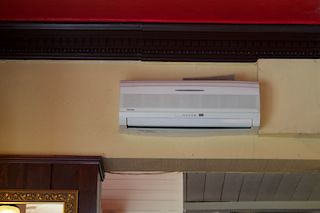Guthrie asks if anything else if different since we were in the UK. Aircon!
While it is very pleasing to us Japanese that the silly English (oh no I've given away the country we are in!) are buying our beautiful, efficient aircon, they really need to learn to leave them switched off until it is at least warm. The one in the photo (Toshiba - hurrah!) isn't actually on, thankfully, or we wouldn't have stayed so long in the pub, but we have several times been in coffee shops, where it is cold outside (under 20C) and even colder in the shop itself, such that we didn't really enjoy having to hang about and drink the coffee. This seems to me to be the opposite of adapting to temperature increase; spending more money on electricity to keep the temperature lower than it has ever been. Seems the Japanese are doing all the "gaman" on this; going to work almost naked and keeping their aircon at 28C. Of course, it is true that a lot of electricity is used in Japan on aircon - it hit 38C in Tokyo yesterday, which means that even aircon set to 28C would be struggling.

4 comments:
Yes, thats a point, more aircon. Mind you, as you say, not many know how to use it properly, and don't seem to have spent the money on a thermostat, and ibn general people don't seem to realise that you can regulate the temperature of rooms and houses by opening and closing windows and switching heating on and off.
Yes the last time I was in the UK for a conference, which was a few years ago, the hotel had the same blasting cold aircon problem. People were sitting in the conference room in their overcoats. I wasn't sure then that this was really a wisespread problem since I can understand that a large building may need to regulate the temperature.
These types of aircon include a thermostat. All you have to do is set them to the desired temperature.
I don'tunderstand the lack of comprehension of thermostats myself. I do get the impression though that a lot of these systems are far bigger and over engineered for what they are required to do, which results in huge drafts of cold air blowing down your neck, rather than a slight breeze keeping the air circulating.
Orpossibly nobody knows how to turn the fan down.
THe opposite problem happened at a conference I was at in Aberdeen in June a few years ago. THey had a central marquee with things going on, and had laid on gas powered air heaters since its usually quite cold in Aberdeen at all times of the year. Nope, they had sweltering hot weather, hottest they'd had in years. And nothing they could do about it. THe central marquee was pretty damn hot.
> I do get the impression though that a lot of these systems are far bigger and over engineered for what they are required to do, which results in huge drafts of cold air blowing down your neck, rather than a slight breeze keeping the air circulating.
Well Japanese home appliances fall well short of over-kill and prefer to err well to the side of inadequate. It is almost like they begrudge the freedom these things could give women, and so perform with deliberate inadequacy to make sure wifey still has plenty of work to do around the house.
As for the aircon, in Japan each year's new aircon is more efficient than any previous. There are available a multitude of different sizes and you buy the one that is right for your room. If you buy one that it is too small it will end up running on full power all summer and winter and wont be able to achieve the desired temperature if the differential between inside and outside is large.
Having said that, even Japanese aircon could be considered larger than necessary if you are using them to maintain a temperature of 19C when it is 20C outside! Tthey are built to cope with much larger temperature differentials and so, for such purposes, they are indeed truely over-engineered.
Post a Comment